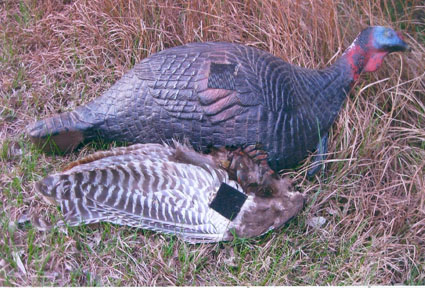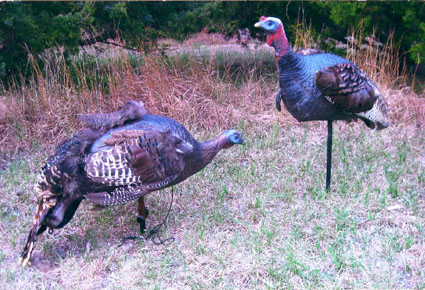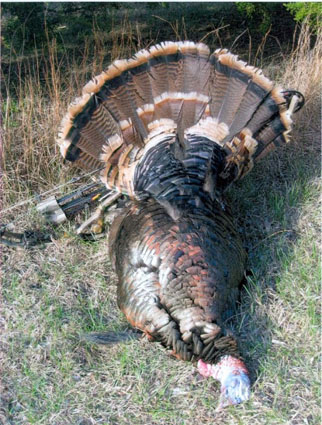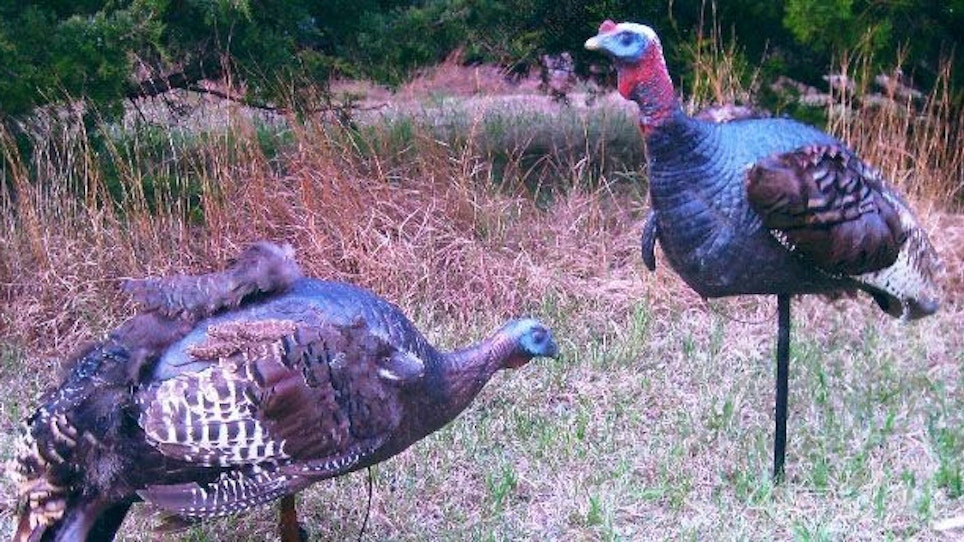 Dennis Carlson attaches real turkey wings to decoys with Velcro for a more realistic effect. |
I often compare bowhunting turkeys with fishing. I’ve pitched enough jigs to know that if I do it in the right situation, I will catch fish. I am confident in the technique even when I do not succeed. Sometimes I speed up the retrieve or add an extra pause, but it is still jigging.
I look at turkey hunting the same way. I’ve developed and refined my basic approach, but I’m not afraid to change things when the birds tell me it isn't right.
My Approach: Zones & Decoys
I look for frequented strut zones or ambush areas. I get there before the birds do, set a pop-up blind, and put out a couple hens and a jake at a distance of 8 to 12 yards. A full-strut tom goes about 10 yards beyond the small flock so it looks like he is moving in on the jake. For more realism, I add real wings to each decoy with Velcro.
If the birds are active, I include a jake’s pelt with the fan propped up in front of the small flock. It looks like the jake just whipped an intruder, and a dominate tom is moving in.
Tom #1: Be Patient
Weeks of part-time observation had produced strut zone possibilities. Unfortunately, a late spring snowstorm on the eve of the 2009 South Dakota opener covered most hotspots with several feet of snow.
Afternoon temperatures rose to the 50s, so I headed out with my gear: a blind, fold-up chair, decoys, and my pack with reading material loaded on an old golf bag cart. I found a snow-free area close to a strut zone along a route toward a roost. I set up and settled in.
Every half-hour I soft-called, just in case. After an hour, I heard birds moving toward the roost. Unfortunately the 50-bird flock was not coming close, and I could not convince any gobblers to leave the group. Not wanting to educate the birds, I relaxed and read. Once they left the field, I would head home.
 Then it happened—a thunderous gobble so close I almost fell off my chair. Peeking out a back window, right behind my blind a mature tom in full strut headed for the decoys. As his shadow appeared in my shooting lane, I drew. Once his shadow finally moved across the window, I shot him at under 10 yards.
Then it happened—a thunderous gobble so close I almost fell off my chair. Peeking out a back window, right behind my blind a mature tom in full strut headed for the decoys. As his shadow appeared in my shooting lane, I drew. Once his shadow finally moved across the window, I shot him at under 10 yards.
After the remaining turkeys were out of sight, I loaded my golf cart and headed for the truck, satisfied that I fooled a mature tom and filled my archery tag.
Tom #2: Learn To Read The Birds
A week later, with double tag in hand, I was at my cousin Bob's place. Bob runs Bob's South Dakota Hunting Service. On a high bank overlooking the creek, we noticed birds over a mile away moving toward the creek bottom roost. We hustled to an ambush point and set out the decoys. Within a half-hour the birds were in the decoys, but the two mature toms would have nothing to do with the setup.
That night, I could not sleep, so I snuck to a mid-morning hunt site that Bob had chosen and set up a blind. I then went to the previous afternoon’s blind along the birds’ usual feed route to set out decoys, then took a nap. I awoke to intense gobbling. Within an hour the hens were in the decoys, but the toms stayed away. The setup that had worked the week before was intimidating these birds.
As I walked back to my truck, Bob called. He had finished morning chores and could be there in 15 minutes if I wanted company. He had an archery tag and had never taken a bird with his bow. I met him on the high observation point. Birds entered the alfalfa field a half-mile from the blind I had set up during the night. We hustled along the creek and scrambled into the blind.
 I crawled to the field and set up a jake and a hen decoy instead of the intimidating full-strut tom. Once back in the blind I tried a few aggressive cuts on my diaphragm call. Immediately, from a food plot only 20 yards behind us, a hen—followed by a jake and then a mature tom—came toward the blind. Bob drew as the tom entered the shooting window. The bird was so close that Bob's arrow would not clear the window opening.
I crawled to the field and set up a jake and a hen decoy instead of the intimidating full-strut tom. Once back in the blind I tried a few aggressive cuts on my diaphragm call. Immediately, from a food plot only 20 yards behind us, a hen—followed by a jake and then a mature tom—came toward the blind. Bob drew as the tom entered the shooting window. The bird was so close that Bob's arrow would not clear the window opening.
"Don't shoot! You have to get higher," I whispered.
Extracting himself from a folding chair while at full draw produced enough commotion that the birds left. As we giggled about it, Bob noticed that birds from the field were now on a dead run toward the decoys. More birds came out of the creek until there were nine jakes running toward our set.
They closed in quickly, and Bob made an excellent shot at 22 yards. His bird collapsed 47 yards from the blind. The entire flock took turns attacking the expired bird. Eventually they tired of it and returned to the decoys. I was able to drop a bird right in the spread. After an hour the birds left the area. We gathered our birds and started back to the trucks.
Bob headed home, and I decided to try my previously unsuccessful blind. This time my decoys included a turkey rug, but no mature tom. Before sunset the flock appeared. My soft yelps again brought the hens to investigate. But now the two mature toms came running in full strut, careening in and out of the decoys. The birds were so committed to the decoys, it seemed like an eternity before I could draw and make a successful shot. The action continued for several more minutes before the birds continued on their way to the roost, minus one mature tom.
Two different weeks, two different situations, and two mature longbeards. My approach in future seasons will still involve pop-up blinds and decoys, but hopefully I will be a little quicker to figure out what the birds are trying to tell me.






